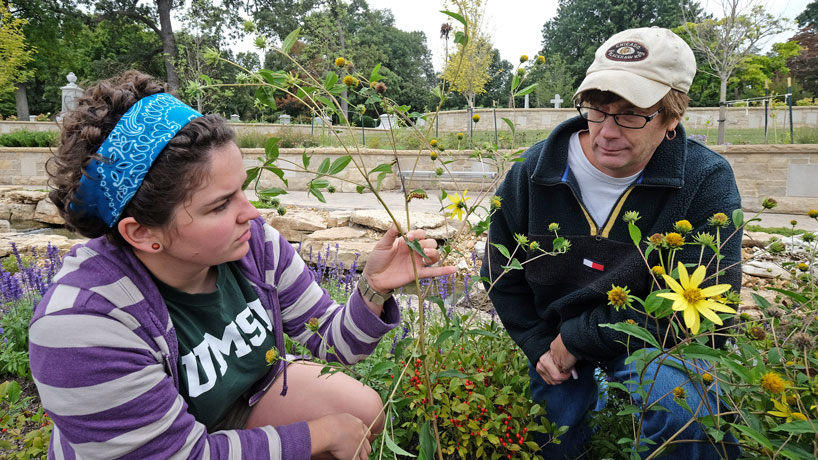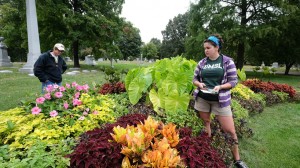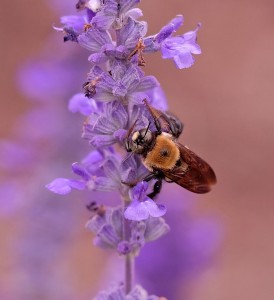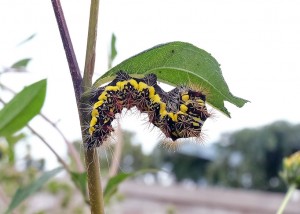
Biology students Hannah Stowe (left) and Randy Anderson researched pollinators’ interactions with native and nonnative plant species at Bellefontaine Cemetery. (Photos by August Jennewein)
Hannah Stowe is the first to admit that she is a fangirl when it comes to beetles.
“It’s the bright colors and the armored-tank kind of look that I like,” she said. “I think they are adorable. People talk about mosquitoes, spiders and the creepy-crawlies they don’t like and don’t want in their house, then all the insects get lumped into that category and suffer from it. Really, I like to fight for the little guy.”
The senior biology major at the University of Missouri–St. Louis does so through conservation research. She and her partner Randy Anderson, another biology student at UMSL, spent several months analyzing insect populations at Bellefontaine Cemetery in north St. Louis County for a semester research project.
“Basically we’re looking at the overall pollinators that are coming to a certain bed of native or nonnative plants and the overall species richness,” Stowe said. “We’re doing that to see whether or not a native plant supports more pollinators than a nonnative plant or a bed of mixed native and nonnative plants.”
The cemetery in coordination with UMSL’s Whitney R. Harris World Ecology Center sponsored the research, which the cemetery commissioned in an effort to practice more environmentally savvy landscaping.
“They didn’t want to just bring in big, showy flowers for people’s benefit,” she said, “but they wanted to try to make it a little more integrated with the actual environment. Prairie recovery is usually a lot of grasses and small flowers and tends to look a little bit weedy – not so much how people would expect a cemetery to look – so they wanted to have a justification for making those choices.”
In this case, the justification is protecting the balance of local insect populations but more specifically pollinator populations. Stowe, who is particularly passionate about being environmentally aware, likes the idea.
“As we’ve gotten more interested in landscaping, it seems like you drive around and see the same kind of plants and flowers everywhere, which is good for those species and whatever is eating those species,” she said, “but it turns out that a lot of the species that were there before are being outcompeted, and we’re losing the diversity in our areas. Protecting our native areas will really help to make sure that we have a variety of flowers, bugs, mammals, birds and everything else.”

Anderson (left) and Stowe observe one of the nonnative flower beds for pollinators at the entrance to Bellefontaine Cemetery.
Stowe and Anderson observed seven locations with paired beds (14 beds total) across the cemetery. They conducted monthly instantaneous surveys requiring them to sit at beds for blocks of time, counting bugs every three minutes and documenting species.
While they didn’t find many of Stowe’s beloved beetles, they did observe lots of pollinators.
“The most of one species we saw were a lot of honey bees and bumble bees,” said Anderson. “That, and a lot of flies.”
Stowe also noted that butterflies were few and far between.
“We’ve seen a couple, a few monarchs and a few more sulfur whites, which is a huge family of butterflies,” she said. “I’ve seen more skippers, which I really like. They hold their wings like jet planes.”
Anderson also noted that the conditions weren’t always optimal for this research.
“We dealt with a lot of rain, which would interrupt our observation times,” he said, “and we’d have to reschedule or just do our best to document what we could.”
And when asked about working in a cemetery, neither Stowe nor Anderson felt nervous or unsettled by their surroundings.
“It’s not like rows and rows of graves. It’s integrated a little bit better than that,” Stowe said. “There are lots of trees, a lot of flowers, a lot of plants. I saw some foxes there, some hawks. It’s very quiet and peaceful, but not morbidly so. It’s a gorgeous area and it’s got a lot of historical figures interred there, so there were actually quite a few people coming and going and taking tours.”
While they are still analyzing and finalizing results, so far their personal observations indicate that there is indeed more species richness on the native plots – good projections for Bellefontaine Cemetery.
The project puts Anderson one step closer to earning his minor in environmental studies and Stowe one step closer to graduate school.
“It’s definitely been a learning experience for sure,” she said. “This is the first time that I’ve done the planning for the research, so it’s been a very valuable experience because I’m looking ahead to a master’s project in the future. Having this under my belt will be very helpful and give me some perspective on framing my future research.”

















